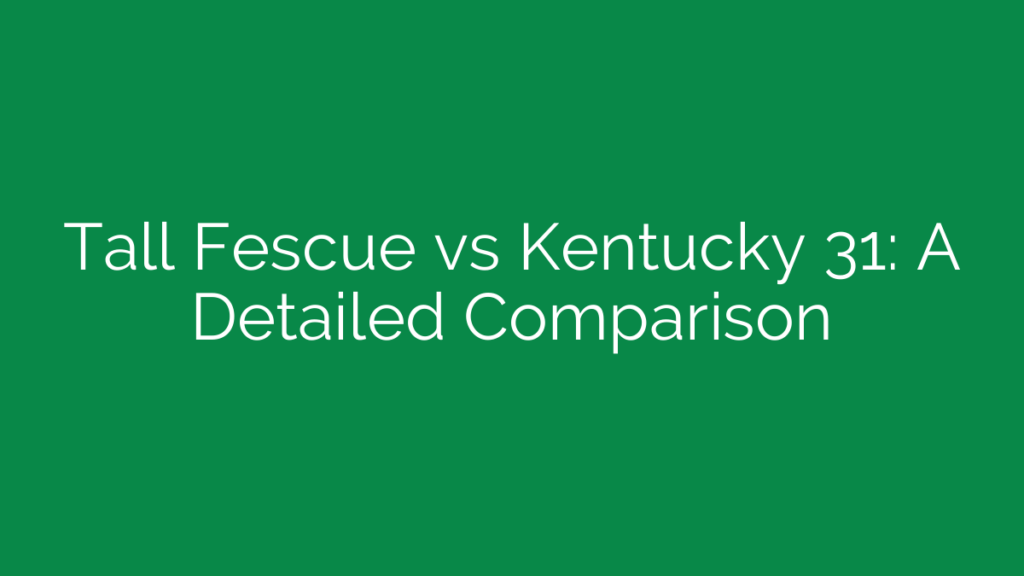Tall fescue and Kentucky 31 (K-31) are two of the most popular cool-season lawn grasses in the United States. Both offer durable, low-maintenance turf, but they have some key differences. This in-depth guide examines the pros and cons of tall fescue vs Kentucky 31 to help you choose the best grass for your lawn.
Origin and History
Tall fescue was introduced to the U.S. from Europe in the 1800s. It gained popularity as a hardy pasture grass before becoming a top lawn grass option.
Kentucky 31, also known as KY-31 or K-31, originated from a remarkable tall fescue discovered in Kentucky in 1931. After being introduced commercially in 1942, it paved the way for tall fescue as a durable,easy-care lawn grass.
Growing Conditions
Both grasses thrive in cool, temperate climates.
- Tall fescue grows well across the northern U.S. and even down into the transition zone. It has good heat tolerance for a cool-season grass but is less hardy in extreme cold than some varieties.
- Kentucky 31 excels in the cool, humid transition zone between the cold north and hot south. It has enhanced heat and drought tolerance compared to many tall fescues.
Appearance
- Tall fescue has a coarse, clumping growth habit. It forms bunches rather than spreading. Modern turf-type cultivars offer a finer blade and smoother turf than traditional tall fescue.
- Kentucky 31 has wider blades and lighter green color compared to more modern turf-type fescues. It provides an economical lawn with decent density.
Growth Habits
- Tall fescue spreads slowly through short underground stems called tillers. This bunch-forming habit makes it easy to contain but less able to repair damage.
- Kentucky 31 spreads actively via above-ground stems called rhizomes. This helps it fill in bare spots but also makes it prone to spreading where it’s not wanted.
Care Needs
- Tall fescue needs about 1 lb of nitrogen per 1,000 sq ft annually. It has deep roots that confer good drought tolerance.
- Kentucky 31 needs 3-6 lbs of nitrogen fertilizer per year. Its shallower roots mean it requires more frequent watering in hot, dry weather.
- Both benefit from fall fertilization and overseeding for optimal lawn health.
Traffic Tolerance
- Tall fescue holds up very well to foot traffic, making it a top choice for lawns that get heavy play.
- Kentucky 31 doesn’t tolerate traffic as well but recovers quickly from damage with its vigorous growth and self-repairing capability.
Shade Tolerance
- Tall fescue needs at least 4 hours of direct sun per day. It has better shade tolerance than many cool-season grasses.
- Kentucky 31 performs best with 8+ hours of sun but tolerates partial shade better than sun-loving warm-season grasses.
Weed and Disease Resistance
- Tall fescue has high resistance to common diseases and weeds like crabgrass.
- Kentucky 31 is more prone to disease and weed pressure, especially in heat and humidity.
Ideal Planting Season
- Tall fescue can be planted in spring or fall, whenever temps are cool. Time seeding for peak growth periods.
- Kentucky 31 does best when seeded in early fall to establish before winter dormancy.
Mixing KY-31 and Tall Fescue
Many experts recommend seed mixes with 80-90% modern turf-type tall fescue and 10-20% Kentucky 31. The tall fescue provides durability while the Kentucky 31 offers improved density and self-repair capability.
Tall Fescue vs Kentucky 31: Key Comparisons
| Characteristic | Tall Fescue | Kentucky 31 |
|---|---|---|
| Climate zone | Cool season – transition zone to northern | Cool season – transition zone |
| Heat/drought tolerance | Very good | Good |
| Cold tolerance | Moderate | Very good |
| Shade tolerance | 4+ hours direct sun | 8+ hours direct sun |
| Growth habit | Clumping, bunch-type | Rhizomatous, spreading |
| Traffic tolerance | Excellent | Moderate |
| Weed/disease resistance | High | Moderate |
| Fertilizer needs | 1 lb N/year/1,000 sq ft | 3-6 lbs N/year/1,000 sq ft |
| Water needs | Low – 1″ per week | Moderate – 1-2″ per week |
| Color | Medium to dark green | Blue-green |
| Texture | Coarse | Medium |
| Best planting time | Spring and fall | Early fall |
When to Choose Tall Fescue
Tall fescue is a great choice if you want:
- A durable northern lawn with enhanced heat/drought tolerance
- High traffic resistance – great for play areas
- Deep green color and coarse lush texture
- Low maintenance and upkeep
- Excellent disease and weed resistance
It’s also ideal if you live in the transition zone or have a yard with partial shade.
When to Choose Kentucky 31
Kentucky 31 may be preferable if you want:
- A low-cost seed that establishes readily
- Improved cold tolerance over other tall fescues
- Lush spreading capability to fill in bare spots
- Rich blue-green color and fine soft texture
- A lawn for a cooler northern climate
KY-31 works well if you don’t mind higher maintenance and are vigilant about proper mowing, watering, and fertilization.
Key Takeaways
- Tall fescue and Kentucky 31 are top cool-season grasses with excellent durability.
- Tall fescue has better heat/drought tolerance while KY-31 offers enhanced cold hardiness.
- Tall fescue needs less maintenance; KY-31 provides better spreading capability.
- For many lawns, a blend offers the benefits of both grasses.
- Choose tall fescue if you want a lower maintenance northern lawn.
- Pick Kentucky 31 for more spreading power and rich color in cool climates.
- Know your climate and lawn needs before deciding between tall fescue vs Kentucky 31.
With their different strengths, tall fescue and Kentucky 31 both continue to be popular choices for low-maintenance lawns. By understanding the key distinctions, you can determine which variety or blend makes the most sense for your climate and lawn care regimen. With the right grass in place, you’ll be on your way to a beautiful, durable lawn.

